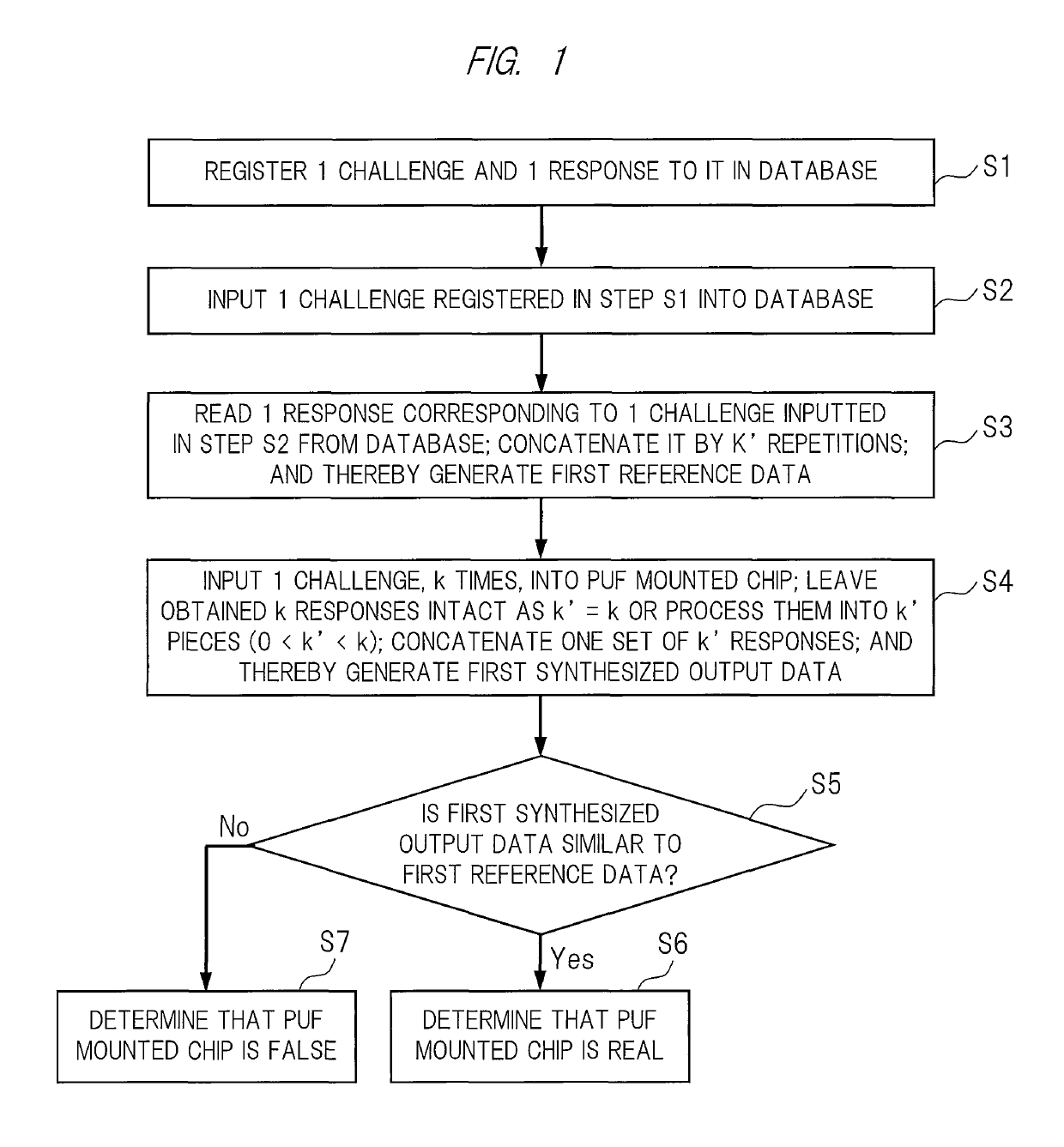Method for controlling error rate of device-specific information and program for controlling error rate of device-specific information
a technology of error rate and device, applied in the direction of fault response, digital transmission, instruments, etc., can solve the problems of large required circuit scale and data size, a certain error rate, and a large required error ra
- Summary
- Abstract
- Description
- Claims
- Application Information
AI Technical Summary
Benefits of technology
Problems solved by technology
Method used
Image
Examples
first embodiment
[0027]With reference to FIGS. 1 and 2, an authenticity deciding method of a PUF mounted chip in a [1, 1, 1, k, k′] mode according to a first embodiment will be described in detail.
[0028]Here, the PUF mounted chip means a semiconductor integrated circuit incorporating a PUF, and the same applies to the following.
[0029]In addition, a [1, 1, 1, k, k′] mode is one of the modes used in the authenticity decision of the PUF mounted chip (hereinafter also referred to as “usage mode”) and, as shown in FIG. 2, means a mode of: inputting one piece of input data (challenge) into a PUF mounted chip IC; registering obtained one piece of output data (response) in a database DB; and using k responses (where k is a natural number of 2 or more in the present embodiment) from the PUF mounted chip IC at a time of authenticity decision.
[0030]It should be noted that the database DB may be another means for storing a response(s) outputted from the PUF mounted chip IC, such as a hard disk and a memory circ...
second embodiment
[0041]With reference to FIGS. 3 and 4, an authenticity deciding method of a PUF mounted chip in the [1, j, j′, 1, 1] mode according to a second embodiment will be described in detail.
[0042]Here, as shown in FIG. 4, the [1, j, j′, 1, 1] mode means a usage mode of: inputting one piece of identical input data (challenge) into the PUF mounted chip IC, j times (where j is a natural number of 2 or more in the present embodiment); leaving obtained j responses intact (j′=j) or processing them into j′ pieces (0<j′<j) (specifically, for example, j pieces are divided into j′ subsets, and the most frequent value of values on each axis of the responses (if there are a plurality of most frequent values, any one of them) within each subset is set as the value on that axis of the response representing that subset) to be registered in the database DB; and using the 1 response from the above PUF mounted chip IC at a time of authenticity decision.
[0043]FIG. 3 is a flowchart showing the authenticity de...
third embodiment
[0053]With reference to FIG. 5, an authenticity deciding method of a PUF mounted chip in a [1, j, j′, k, k′] mode according to a third embodiment will be described in detail.
[0054]Here, the [1, j, j′, k, k′] mode means a usage mode of: inputting one piece of identical input data (challenge) into the PUF mounted chip IC, j times (where j is a natural number of 2 or more in the present embodiment); leaving obtained j pieces of the response intact (j′=j) or processing them into j′ pieces (0
[0...
PUM
 Login to View More
Login to View More Abstract
Description
Claims
Application Information
 Login to View More
Login to View More - R&D
- Intellectual Property
- Life Sciences
- Materials
- Tech Scout
- Unparalleled Data Quality
- Higher Quality Content
- 60% Fewer Hallucinations
Browse by: Latest US Patents, China's latest patents, Technical Efficacy Thesaurus, Application Domain, Technology Topic, Popular Technical Reports.
© 2025 PatSnap. All rights reserved.Legal|Privacy policy|Modern Slavery Act Transparency Statement|Sitemap|About US| Contact US: help@patsnap.com



